
Lavandula is a genus of 47 known species of flowering plants in the mint family, Lamiaceae. It is native to the Old World and is found in Cape Verde and the Canary Islands, and from Europe across to northern and eastern Africa, the Mediterranean, southwest Asia to India.
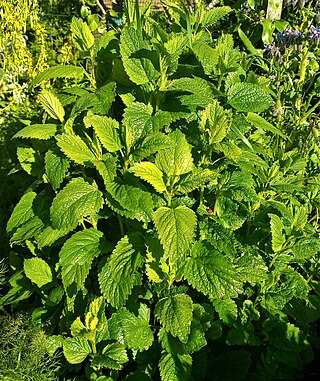
Lemon balm is a perennial herbaceous plant in the mint family and native to south-central Europe, the Mediterranean Basin, Iran, and Central Asia, but now naturalised elsewhere.

An essential oil is a concentrated hydrophobic liquid containing volatile chemical compounds from plants. Essential oils are also known as volatile oils, ethereal oils, aetheroleum, or simply as the oil of the plant from which they were extracted, such as oil of clove. An essential oil is essential in the sense that it contains the essence of the plant's fragrance—the characteristic fragrance of the plant from which it is derived. The term "essential" used here does not mean indispensable or usable by the human body, as with the terms essential amino acid or essential fatty acid, which are so called because they are nutritionally required by a living organism.
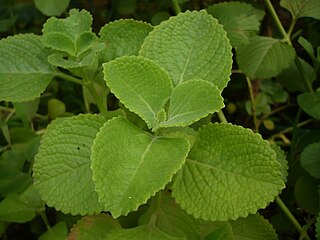
Coleus amboinicus, synonym Plectranthus amboinicus, is a semi-succulent perennial plant in the family Lamiaceae with a pungent oregano-like flavor and odor. Coleus amboinicus is considered to be native to parts of Africa, the Arabian Peninsula, and India, although it is widely cultivated and naturalized elsewhere in the tropics where it is used as a spice and ornamental plant. Common names in English include Indian borage, country borage, French thyme, Indian mint, Mexican mint, Cuban oregano, soup mint, Spanish thyme. The species epithet, amboinicus refers to Ambon Island, in Indonesia, where it was apparently encountered and described by João de Loureiro (1717–1791).

Cannabis sativa is an annual herbaceous flowering plant indigenous to Eastern Asia, but now of cosmopolitan distribution due to widespread cultivation. It has been cultivated throughout recorded history, used as a source of industrial fiber, seed oil, food, recreation, religious and spiritual moods and medicine. Each part of the plant is harvested differently, depending on the purpose of its use. The species was first classified by Carl Linnaeus in 1753. The word sativa means "things that are cultivated."

Rose oil is the essential oil extracted from the petals of various types of rose. Rose ottos are extracted through steam distillation, while rose absolutes are obtained through solvent extraction, the absolute being used more commonly in perfumery. The production technique originated in Greater Iran. Even with their high price and the advent of organic synthesis, rose oils are still perhaps the most widely used essential oil in perfumery.

Pinene is a collection of unsaturated bicyclic monoterpenes. Two geometric isomers of pinene are found in nature, α-pinene and β-pinene. Both are chiral. As the name suggests, pinenes are found in pines. Specifically, pinene is the major component of the liquid extracts of conifers. Pinenes are also found in many non-coniferous plants such as camphorweed (Heterotheca) and big sagebrush.
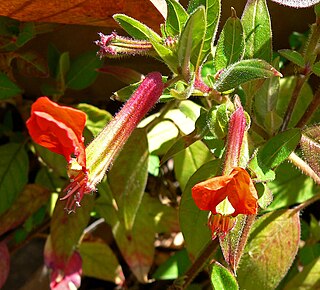
Cuphea is a genus containing about 260 species of annual and perennial flowering plants native to warm temperate to tropical regions of the Americas. The species range from low-growing herbaceous plants to semi-woody shrubs up to 2 m tall. Commonly they are known as cupheas, or, in the case of some species, as cigar plants. The generic name is derived from the Greek word κυφος (kyphos), meaning "bent," "curved," or "humped."

Caryophyllene, more formally (−)-β-caryophyllene,(BCP), is a natural bicyclic sesquiterpene that is a constituent of many essential oils, especially clove oil, the oil from the stems and flowers of Syzygium aromaticum (cloves), the essential oil of Cannabis sativa, rosemary, and hops. It is usually found as a mixture with isocaryophyllene (the cis double bond isomer) and α-humulene (obsolete name: α-caryophyllene), a ring-opened isomer. Caryophyllene is notable for having a cyclobutane ring, as well as a trans-double bond in a 9-membered ring, both rarities in nature.

Humulene, also known as α-humulene or α-caryophyllene, is a naturally occurring monocyclic sesquiterpene (C15H24), containing an 11-membered ring and consisting of 3 isoprene units containing three nonconjugated C=C double bonds, two of them being triply substituted and one being doubly substituted. It was first found in the essential oils of Humulus lupulus (hops), from which it derives its name. Humulene is an isomer of β-caryophyllene, and the two are often found together as a mixture in many aromatic plants.
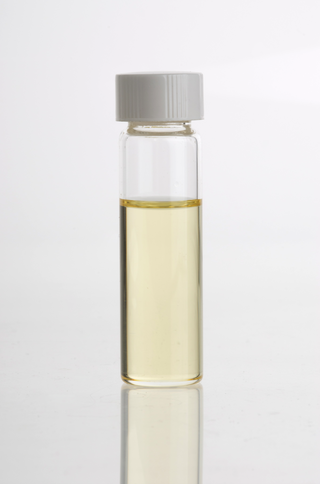
Oil of clove, also known as clove oil, is an essential oil extracted from the clove plant, Syzygium aromaticum. Clove oil is commonly used in aromatherapy and for flavoring food and some medicines. Madagascar and Indonesia are the main producers of clove oil.
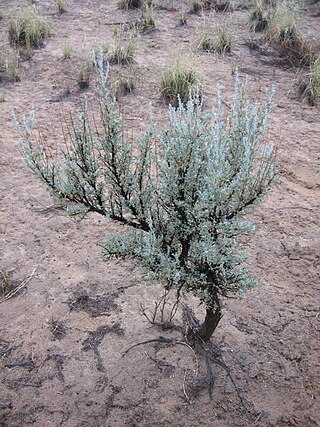
Sesquiterpenes are a class of terpenes that consist of three isoprene units and often have the molecular formula C15H24. Like monoterpenes, sesquiterpenes may be cyclic or contain rings, including many unique combinations. Biochemical modifications such as oxidation or rearrangement produce the related sesquiterpenoids.

Cannabis flower essential oil, also known as hemp essential oil, is an essential oil obtained by steam distillation from the flowers, panicles, stem, and upper leaves of the hemp plant. Hemp essential oil is distinct from hemp seed oil and hash oil: the former is a vegetable oil that is cold-pressed from the seeds of low-THC varieties of hemp, the latter is a THC-rich extract of dried female hemp flowers (marijuana) or resin (hashish).

Cryptocarya agathophylla is a member of the laurel family, Lauraceae, and originates in Madagascar.

Monodora myristica, the calabash nutmeg, is a tropical tree of the family Annonaceae or custard apple family of flowering plants. It is native to Angola, Benin, Cameroon, the Central African Republic, the Democratic Republic of the Congo, Equatorial Guinea, Gabon, Ghana, Guinea-Bissau, Ivory Coast, Kenya, Liberia, Nigeria, the Republic of the Congo, Sierra Leone, Sudan, Tanzania, Togo and Uganda. In former times, its seeds were widely sold as an inexpensive nutmeg substitute. This is now less common outside its region of production. Other names of calabash nutmeg include Jamaican nutmeg, African nutmeg, ehuru, ariwo, awerewa, ehiri, airama, African orchid nutmeg, muscadier de Calabash and lubushi.

Amyris is a genus of flowering plants in the citrus family, Rutaceae. The generic name is derived from the Greek word αμυρων, which means "intensely scented" and refers to the strong odor of the resin. Members of the genus are commonly known as torchwoods because of their highly flammable wood.

Thymus pannonicus, known by its common name Hungarian thyme or Eurasian thyme, is a perennial herbaceous plant, distributed in central and eastern Europe and Russia. It grows over open dry meadows, grasslands, and rocks.
Bunium elegans is a species of flowering plant in the family Apiaceae found in Syria and Lebanon. A specimen is kept at the Muséum National d'Histoire Naturelle in Paris. The plant contains essential oils.
Ottoa is a monotypic genus of flowering plants belonging to the family Apiaceae. It only contains one known species, Ottoa oenanthoides.

Dianella ensifolia is a flowering plant, of the family Asphodelaceae. It is native to southern China, India, Japan, Madagascar, Malesia, the Pacific Islands, Singapore, Sri Lanka, Taiwan, and tropical Asia. Its common names include umbrella dracaena, common dianella, siak-siak, and flax lily.

















